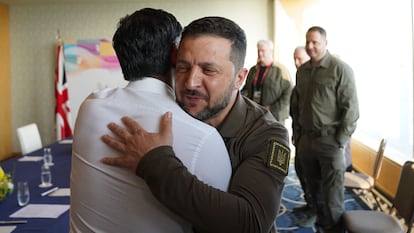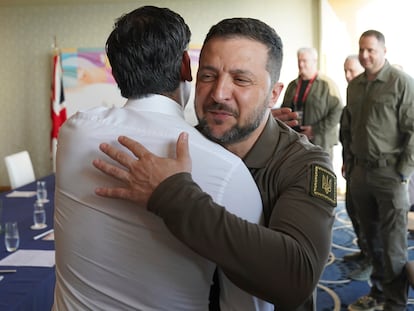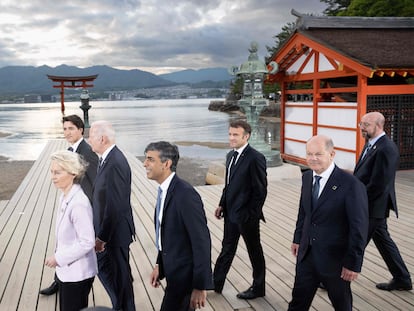G7 summit marks a diplomatic and military shift for the war in Ukraine
The prospect of delivering F-16 fighter jets to the embattled country – as well as President Zelensky’s activism at the international forum – will influence the future of the conflict


The G7 summit in Hiroshima, Japan has led to a significant shift regarding the war in Ukraine. The American government’s decision – after months of reluctance – to allow the delivery of F-16 fighter jets to the embattled country opens up a new military dimension to the conflict. Of course, the effect won’t be immediate, since it will take months before the requisite training and supply of planes can be carried out. However, it’s clear that, when these jets do become available, Kyiv will have a huge boost. Moscow has reacted angrily to this news, warning that the measure entails “colossal risks” for Western countries – in keeping with the usual deployment of threats to deter opponents.
The issue of the F-16s is not the only twist that the summit has brought about. The surprise presence of Ukrainian President Volodymr Zelensky constitutes a diplomatic leap. After a long period in which he did not leave his country, Zelensky has been embarking on a series of bilateral and multilateral meetings, making for a vibrant presence at global forums.
In addition to the seven member nations of the political forum, the leaders of India, Brazil, Indonesia, Vietnam, Australia and South Korea, among others, are present at the G-7 meeting in Japan. And, the day before he arrived, the Ukrainian president made a stopover in Saudi Arabia to speak at the Arab League summit. Russian President Vladimir Putin has a more limited radius of action than Zelensky when it comes to the personal diplomatic battlefield – a major difference between the two opposing leaders.
In addition to the military and diplomatic discussion, there is a third element at the G7 meeting which could further erode Russian capabilities. The seven countries are planning on further limiting key strategic exports to the Eurasian giant, which could hinder the ability of its industrial machinery to function. They will also expand sanctions across the diamond sector – a lucrative business for Russia. The G7 is now warning third parties that providing material support to Russian aggression will result in consequences. While these measures don’t represent a lethal blow to the Kremlin, they do send a message that the screws are tightening on Putin’s regime. Support for Kyiv is durable – perhaps even unshakable.
Thus, Hiroshima represents a turning point – not in the sense of conflict resolution per say, but in the sense of changing the terrain in the medium and long-term. Despite the initiatives by China and Brazil, the war is likely going to go on for a long time… and if the Kremlin calculated that Western support for Ukraine would eventually dwindle, the summit at Hiroshima has been a bitter response to this erroneous prediction.
Washington spent months resisting Kyiv’s request for F-16s – which had been endorsed by some European countries – in a policy of prudence that also stalled the consideration of supplying Zelensky’s government with HIMARS missiles, Patriots or Western tanks. But now, it appears that US President Joe Biden – who had been concerned about the possibility of said planes being used to attack targets on Russian soil – has finally relented.
On Friday, May 19, Biden gave his support to an international initiative to start training Ukrainian pilots for the use of these fighter jets. And, the following day, US National Security Adviser Jake Sullivan cleared up any doubts about this: “As the training unfolds in the coming months, we will work with our allies to determine when planes will be delivered, who will be delivering them, and how many.”
The F-16s are not the most advanced model that the United States produces, but they are clearly superior to Ukraine’s Mig-29s and Su-27s. Russia, on the other hand, is using the Su-35 – a model that is inferior to the F-16, but better than the ones that Ukraine currently has access to.
After landing in Hiroshima aboard a French government plane, Zelensky immediately began a series of bilateral meetings with leaders such as British Prime Minister Rishi Sunak, French President Emmanuel Macron, German Chancellor Olaf Scholz, Indian Prime Minister Narendra Modi, among others.
The presence of Modi and Brazilian President Luiz Inácio Lula da Silva are related to Zelensky’s attendance. New Delhi has close ties with Moscow for historical reasons; India has abstained at the UN on the vote regarding the Russian invasion, while Modi has expanded trade ties with Putin amid geopolitical tensions over Ukraine. Brasilia, meanwhile – which did condemn the invasion at the UN – is promoting a peace initiative that has caused a lot of skepticism among Westerners.
The key player in all of this, of course, is China. In their final communiqué upon the conclusion of the summit, the G7 members ask Beijing to use its influence to push for a Russian withdrawal. India is also a major player, because of its economic size and the oxygen it provides Russia by purchasing huge amounts of oil.
For months, Western powers have been trying to convince countries in the Global South to get on Ukraine’s side. While many of these nations have no sympathy for Russian aggression, they are also suspicious of what they consider to be Western hypocrisy… the invasion of Iraq in 2003 comes to mind. Hence, the G7 is seeking to develop an argument on the basis of the adherence to international principles – regarding the inviolability of the territory and sovereignty of states – rather than trying to appeal to potential allies on a moral level regarding the struggle between democracies and authoritarian regimes. Zelensky is expected to also follow this path, in adherence to the values of the UN Charter.
The summit in Japan is intended to demonstrate that Western powers are by no means fatigued in terms of supporting Ukraine. The EU has managed to successfully overcome the risk of an energy crisis, while the region’s economy has not suffered as much as expected from the war and its resulting inflationary flare-up. And now, military support is about to be stepped up, at great cost, although the G7 affirms that it has budgeted enough support for Ukraine for the rest of 2023 and into 2024.
On the battlefield, meanwhile, there are signs that the expected Ukrainian counteroffensive may be successful. If so, this would be a collective morale booster for the Ukrainians and their partners. But the F-16 announcement puts everything in a different context. It signals that support is here to stay.
Looking to strengthen ties with the Global South
Last year, the German presidency of the G7 extended invitations to several countries in the Global South – such as India, Indonesia, Argentina and Senegal – to attend the summit. This year, the host nation – Japan – has repeated this same gesture, conveying a willingness to strengthen ties between major powers and a broad batch of countries that may not all necessarily be aligned in the conflicts between Russia, China and the West.
A large majority of UN member states voted against the Russian invasion… but only about 40 have implemented sanctions against Moscow. Likewise, although many countries are suspicious of dealing with China, the vast majority are interested in receiving investments and loans from Beijing, while bolstering trade with the Asian giant. And of course, many countries reproach the West for its heavy hypocrisy, comparing its current rhetoric with the 2003 invasion of Iraq. Across the board, governments and peoples criticize a distribution of power in international institutions that reflects an old balance of power – almost eight-decades-old – that no longer corresponds to reality.
The G7 governments are aware of these problems and are trying to change course. They are seeking to come up with an alternative investment plan to China’s famous Silk Road Initiative, while also trying to stay away from counterproductive moralizing. Within their ranks, Japan and Germany are among the most sensitive to the concerns of the Global South… particularly because the post-World War II balance of power does not favor them.
China is fighting hard to position itself, while India is also seeking greater respect. Time will tell if there will be any movement in the position of non-aligned countries towards the war in Ukraine.
Sign up for our weekly newsletter to get more English-language news coverage from EL PAÍS USA Edition
Tu suscripción se está usando en otro dispositivo
¿Quieres añadir otro usuario a tu suscripción?
Si continúas leyendo en este dispositivo, no se podrá leer en el otro.
FlechaTu suscripción se está usando en otro dispositivo y solo puedes acceder a EL PAÍS desde un dispositivo a la vez.
Si quieres compartir tu cuenta, cambia tu suscripción a la modalidad Premium, así podrás añadir otro usuario. Cada uno accederá con su propia cuenta de email, lo que os permitirá personalizar vuestra experiencia en EL PAÍS.
¿Tienes una suscripción de empresa? Accede aquí para contratar más cuentas.
En el caso de no saber quién está usando tu cuenta, te recomendamos cambiar tu contraseña aquí.
Si decides continuar compartiendo tu cuenta, este mensaje se mostrará en tu dispositivo y en el de la otra persona que está usando tu cuenta de forma indefinida, afectando a tu experiencia de lectura. Puedes consultar aquí los términos y condiciones de la suscripción digital.
More information
Archived In
Últimas noticias
Most viewed
- Reinhard Genzel, Nobel laureate in physics: ‘One-minute videos will never give you the truth’
- Oona Chaplin: ‘I told James Cameron that I was living in a treehouse and starting a permaculture project with a friend’
- Pablo Escobar’s hippos: A serious environmental problem, 40 years on
- Charles Dubouloz, mountaineering star, retires at 36 with a farewell tour inspired by Walter Bonatti
- Why we lost the habit of sleeping in two segments and how that changed our sense of time










































